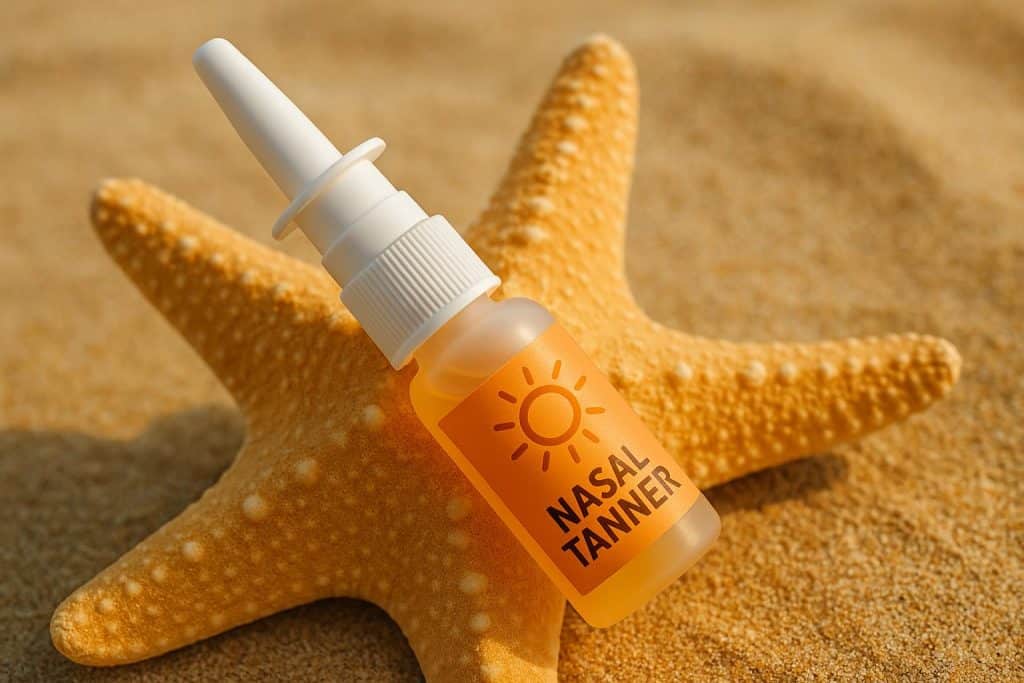When you scroll TikTok, between all those dance routines and cooking hacks, you may end up watching a solution to a year-round golden tan without a single UV ray. That is how an algorithm works: bringing you face to face with the latest beauty craze, the “nasal tanners”.
Trending globally on TikTok, these nasal tanners are supposedly a convenient and “safer” alternative to controversial tanning injections. But is that really the truth? Is achieving a golden glow like influencers really that simple and safe? Is this viral shortcut a healthy method to bronzed skin, or a dangerous walk into the uncharted?
What are nasal tanners and how do they work?
At the surface level, nasal tanning sprays are the new method for the use of a rather controversial substance: melanotan-II. For the unfamiliar, it is a synthetic name of the alpha-melanocyte-stimulating hormone (α-MSH). Basically, a lab-made chemical that replicates the one your body naturally produces to stimulate melanin, the pigment responsible for skin and hair color.
Earlier, Melanotan-II was administered into the body through subcutaneous injection. Users would self-inject the peptide, often after reconstituting it from a powdered form. Now this process was rife with potential for error. Hence, in an attempt to make the process simpler and more direct, this new wave of nasal tanners started to make rounds via discreet routes.
Widely marketed as nasal sprays or “tanning nasal drops,” users simply have to administer a few spritzes into each nostril. The peptide is then directly absorbed through the nasal mucosa into the bloodstream, activating a mechanism that ultimately boosts melanin production, resulting in skin darkening, and supposedly, minimal sun exposure.
The “safer than injections” myth
The primary reason why using nasal tanners became a trend was due to the perception that it is inherently safer than injections. Now, this is a widespread myth that is compelling to users, yet it is a dangerously misleading narrative.
So, let’s break this myth:
- Same unregulated drug
Whether injected or sniffed, the main active ingredient is the same synthetic peptide: Melanotan-II. Irrespective of the administered method, the substance is not approved by the respective regulatory bodies, such as the FDA, the MHRA in the UK, or any other major medical authority for cosmetic tanning. Currently, it is only sold as a “research chemical,” bypassing the rigorous safety, efficacy, and purity testing required for human medications. This proves that using the drug in any form means gambling with your health and the law. Moreover, sellers do not provide any guarantee of the bottle’s concentration, sterility, or the data on other substances it might contain.
- The illusion of simplicity and control
People are usually more used to a nasal spray than a syringe. Since it is less clinical, it creates a false sense of security, suggesting the dose is more controlled and the process less invasive. However, the actual scene is different. Nasal absorption can be highly inconsistent due to variables such as nasal congestion, spray technique, and individual differences in nasal mucosa. At one time, you might get a small, partially effective dose; the next, you could absorb a much larger, potentially dangerous quantity.
Beyond the Suntan – The realistic risks of nasal tanners
Choosing a different route to administer Melanotan-II won’t eliminate the known side effects of it; in some cases, it might just introduce new ones. Nasal tanners are no exception.
Common and uncomfortable side effects
In the early stages, many users reported experiencing significant nausea, facial flushing, and appetite suppression. A more concerning issue is reports of spontaneous erections in men (a side effect that led to its study as a potential treatment for erectile dysfunction) and darkening of moles or skin lesions.
Now, darkening or enlargement of skin lesions can be critical from the medical viewpoint. Since using this drug artificially stimulates melanin production in the body, the peptides can cause existing moles to darken and grow, making it harder to detect and confirm whether they are a normal skin change or signs of potential skin cancer.
The serious dangers of nasal administration
- Direct pathway to the brain: The nasal cavity is a direct route to the olfactory nerve and the brain via the cribriform plate. This “nose-brain connection” is a legitimate area of scientific research for drug delivery. Therefore, inhaling an unregulated peptide poses unknown neurological risks.
- Local damage: The nasal mucosa is a delicate organ. Repeated use of an unregulated chemical solution may cause irritation, chronic inflammation, nosebleeds, and potentially damage the sense of smell.
- Infection risk: Since there is no official route of its accessibility and safety, spraying non-sterile products directly into the nasal passages can introduce bacteria and fungi, which can lead to severe sinus infections or, in worst-case scenarios, fatal infections to the brain.
The long-term unknown
Scientific documents suggest that Melanotan-II was abandoned in late-stage clinical trials for a reason. Why? The reason could be anything. But what’s undeniable is its long-term effects on the body, including its potential impact on the cardiovascular system and its role in stimulating the melanoma growth (the deadliest form of skin cancer), are simply unknown.
All in all, using these products means inviting uncontrolled experimentation with your health.
Why the craze persists
The persistence of the melanotan trend, in any form, speaks volumes about the societal desire for a “healthy” tan. Now this is a paradox in itself, given that artificial tanning literally damages skin. However, TikTok’s algorithm continues to simplify these trends at a dizzying pace. And the truth? It remains almost untouched in some digital corner.
It is common for users to fall under the allure of a quick, effortless tan, but remember, nasal tanners are not a safer alternative to injections. They are simply a different way to administer the same dangerous, unregulated drug.
Therefore, make your own safe choice.
